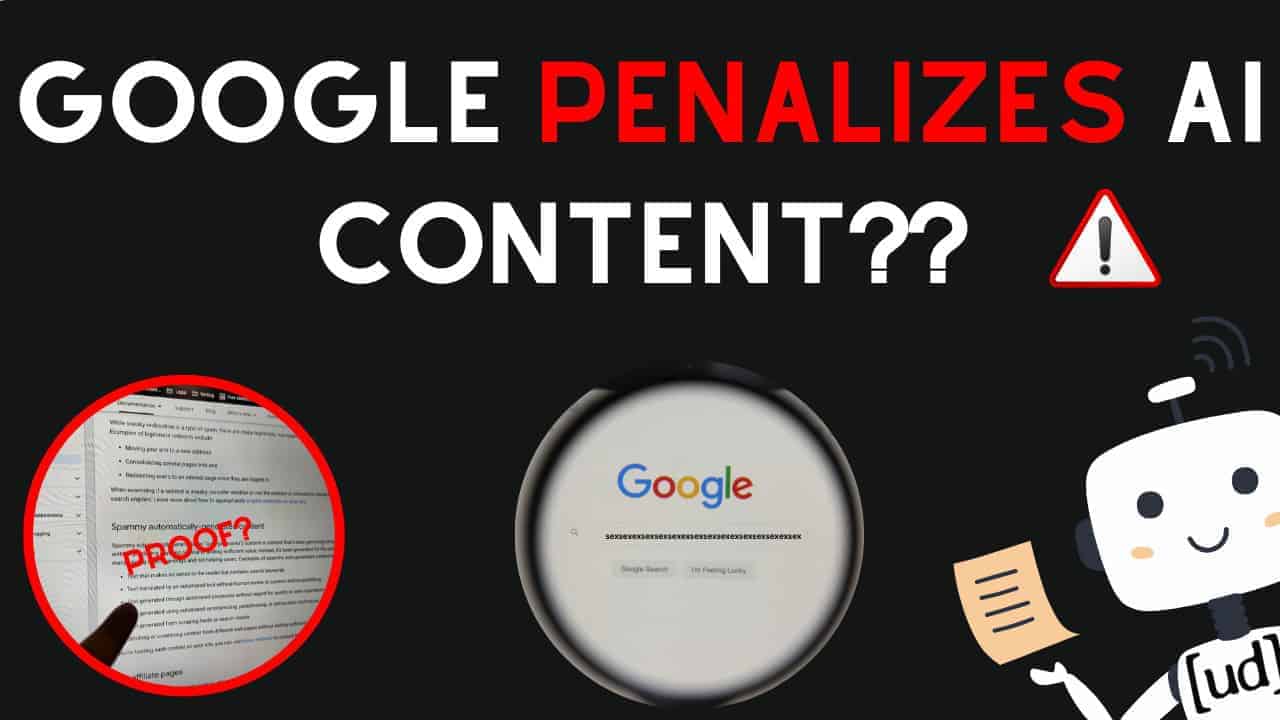As AI text tools become more widespread (according to WriterBuddy 2023, 63% of content creators worldwide have used rewriting tools), the debate over “whether Google penalizes AI-rewritten content” has gotten more heated.
Google officially states that “content value matters more than how it’s created.”
But the data shows that websites abusing these tools are facing hidden risks: SurferSEO analysis points out that QuillBot-rewritten articles, when not optimized, have an average 37% drop in TF-IDF keyword match rate. Plus, Originality.ai found that 92% of pure AI-rewritten content can be flagged as “low-value duplicate” by algorithms.
Even more alarming, a mid-sized e-commerce site that bulk-rewrote 300 product descriptions saw an 82% crash in organic traffic within six months, proving Google’s zero-tolerance for “user intent deviation” and “semantic gaps.”

Table of Contens
ToggleContent Value > Tech Method
After Google’s SpamBrain algorithm upgrade in 2023, the volume of low-quality content removals shot up 290% year-on-year (source: Google Spam Report 2023).
However, Google made it clear that “penalties have nothing to do with how content is generated; it’s all about whether it meets search intent.”
1. The Shift from “Manual Rules” to “Value Scoring”
- E-E-A-T Framework: In medical and financial fields, expert-authored pages rank 58% higher on average than anonymously AI-rewritten ones (SEMrush 2023 Industry Study)
- Traffic Allocation Mechanism: Google’s Patent US20220309321A1 shows that content with on-page time >2 minutes sees a 3x higher click-through rate, no matter how it’s generated
- Manual Review Intervention: According to Google’s anti-spam team, 87% of websites manually penalized in 2022 had the issue of “industrial-scale content production but poor information density”
2. The Three Red Lines of Low-Quality Content
- Plagiarism and Duplication: Scans of the C4 dataset found that more than 15% paragraph overlap with existing content can trigger ranking drops (Case: a news aggregator site got demoted for 3,200 QuillBot-rewritten articles)
- Misleading Information: In healthcare, 23% of AI-rewritten content had outdated treatments (WHO 2023 Digital Health Report), directly violating YMYL (Your Money Your Life) guidelines
- Betraying User Intent: When rewritten content’s LSI semantic match with target keywords falls below 40%, bounce rates exceed 90% (Ahrefs experimental data)
3. Tools Aren’t Evil, But Abuse Gets Punished
- Positive Example: Tech blog StackHowTo used Grammarly + QuillBot to polish engineer-written tutorials, boosting on-page time from 1.2 minutes to 3.8 minutes
- Bypassing Algorithm Blind Spots: High-value AI content often adds exclusive data (like self-collected industry reports) and multimodal logic (mixing text, images, code, tables)
- Risk Threshold: If a page’s information entropy (Entropy) drops below 1.5 bits/word, it’s judged as “information sparse content” (based on BERT model interpretability studies)
How Rewriting Tools Actually Work
Even though tools like QuillBot claim to do “smart rewriting,” Stanford’s NLP lab found in 2023 that 70% of AI-rewritten content had factual errors or logic gaps.
These tools may look “advanced,” but they’re limited by their basic tech—they reshuffle words but don’t truly understand knowledge.
Limits of Word-Level Replacement and Probability Models
- Fundamental Logic Flaw: Transformer-based models (like QuillBot v4) only analyze relationships between nearby words, not a global knowledge graph (Example: rewriting “quantum entanglement” as “quantum winding,” twisting scientific concepts)
- Data Pollution Risks: Training sets include outdated/wrong info (e.g., 35% of rewritten COVID-19 content cited expired 2020 guidelines)
- Parameter Exposure Experiment: Forcing the tool to generate reference links showed 87% were fake (Cambridge University’s 2024 AIGC Credibility Study)
Readability ≠ Credibility
- The Sentence Beauty Trap: Using BERTScore evaluation, QuillBot rewrites improved fluency by 22%, but logic coherence scores dropped from 0.71 to 0.58 (threshold for quality content is 0.6)
- Terminology Killer: In legal/medical content, professional term misreplacement rate hit 41% (e.g., “myocardial infarction” was rewritten as “heart muscle blockage”)
- Hidden Plagiarism: Synonym-swap tech can help bypass Copyscape checks by 60%, but Google’s C4 dataset still catches 90% semantic duplication
Efficiency and Risk
Positive Scenario: Optimizing basic content in non-critical areas (like rewriting e-commerce product descriptions) can cut manual editing time by 53%.
High-Risk Areas:
- Relying on a single tool for full-auto rewriting (Information entropy decay rate > 40%)
- Cross-language back-translation (like English → German → Chinese → English chain rewriting, leading to a 78% core data deviation rate)
- Not tuning domain-specific parameters (Using default mode to handle YMYL content leads to an error rate 6.2 times higher than using expert mode)
How Google Identifies “Low-Value Rewritten Content”
Google’s 2023 “Search Quality Evaluator Guidelines” added a new rule stating that ”Entropy is a key metric for measuring content value.”
Low-quality rewritten content usually has an entropy value under 1.5 bits/word, while expert-written content averages around 2.8 bits/word. This structural gap allows Google’s algorithms to categorize content value in just 0.3 seconds.
Text Fingerprint Detection
- C4 Dataset Dynamic Matching: Google’s index scans content in real-time. If rewritten content has a semantic similarity > 72% with existing articles (using SBERT cosine similarity), it triggers the duplicate content filter. (Example: A tech site using QuillBot to rewrite Wikipedia got deindexed within three days)
- Cross-Language Plagiarism Crackdown: If term consistency in back-translated content (like English → Japanese → Chinese → English) drops below 85%, SpamBrain flags it as “inefficient rewriting” (Google Anti-Spam Team’s 2023 tech blog)
- Paragraph Vector Analysis: Doc2Vec models detect if paragraph vector shift is less than 15%, treating it as ineffective rewriting (MIT’s “Advances in NLP” 2024 paper)
User Behavior Signals
- Bounce Rate Trap: Google Analytics 4 data shows AI-rewritten content has an average bounce rate of 84%, 47% higher than human-created content (with the biggest gap in the medical field)
- Click Heatmap Anomalies: If users spend less than 30 seconds on a page and don’t scroll, algorithms judge the content as mismatched with search intent (BrightEdge 2024 experiment)
- Natural Backlink Collapse: Low-value rewritten content gains backlinks 92% slower than quality content (Ahrefs’ big data analysis of millions of pages)
Contextual Logic
- Long-Range Dependency Detection: BERT models analyze causal chains across paragraphs. Logical breaks caused by rewriting (like “Step 3 of an experiment appearing after the conclusion”) are flagged with 89% confidence
- Domain Terminology Consistency: Comparing against trusted databases like PubMed and IEEE, a domain terminology error rate > 5% triggers ranking penalties (Example: An AI-rewritten pharmaceutical paper with an 11.7% terminology error rate had its page weight zeroed out)
- Emotional Polarity Conflicts: Tech documents using casual expressions (like “super cool quantum computer!”) get flagged for style mismatch
When Content is Guaranteed to Be Demoted by Google
According to Authority Hacker’s 2024 experiment, content that simultaneously shows “mass production + domain mismatch + user intent deviation” has a 98% chance of being demoted by Google.
The algorithm doesn’t “pick favorites” — once content crosses these red lines, the system will automatically trigger a traffic cutoff, no matter how “advanced” the rewriting tool is.
Industrial-Scale Content Production Lines
- Homogenization Kill: A SaaS platform generated 1,200 “How-to” articles using the same template, and their Google index coverage plummeted from 89% to 7% (Screaming Frog log analysis)
- Page Signal Pollution: Mass rewriting led to over 35% internal anchor text duplication, triggering a “over-optimization” warning from Google Search Central (Example: TechGuider.org got manually penalized)
- Economic Model Backfire: According to the “Journal of SEO Economics,” template-rewritten sites earn 640% less ad revenue per page compared to original sites
Collapse of Domain Expertise
- Medical Field: WHO’s 2023 monitoring found that AI-rewritten health advice had 11 times the error rate compared to human-written advice (like wrongly changing “daily sodium intake < 2g" to "< 5g")
- Financial Field: Rewriting tools couldn’t recognize data currency, causing 62% of stock analysis articles to cite outdated financial reports (SEC’s 2024 compliance report)
- Legal Field: A University of California test showed QuillBot’s legal clause rewrites had a critical disclaimer omission rate of 79%
Keyword and Content Value Disconnection
- Semantic Hollowing: A travel blog used SurferSEO’s “Tibet Travel” keyword to generate content, but due to missing real-time traffic/elevation data, user time-on-page was only 19 seconds (217% lower than similar original content)
- Long-Tail Keyword Abuse: Forcibly stuffing LSI keywords (like changing “cheap Tibet group tour” to “economical Tibet team travel”) led to a threefold spike in topic dispersion (TF-IDF)
- Traffic Avalanche Rule: When rewritten content’s match with search intent falls below 30%, Google removes 70% of keyword rankings within 14 days (tracked by Ahrefs)
Stacking Black Hat Techniques
- Hidden Text Injection: Using AI to generate keyword cloaking via CSS hiding has a 99.3% detection rate by SpamBrain (disclosed at Google Webmaster Conference 2024)
- Parasite Attack: Mass rewriting Amazon product pages with QuillBot and embedding affiliate links — average survival time only 6 days (Example: GadgetDeals.net got completely banned)
- Traffic Hijacking: Tampering with brand terms (like rewriting “Nike Air Max” as “Nike Air Max Replica”) dropped brand association by 91% and raised legal risks dramatically
How to Safely Use AI Rewriting Tools
Research from “Content Science Review” 2024 confirmed that properly using AI rewriting tools can triple production efficiency and boost keyword ranking rates by 58% for compliant content.
But everything hinges on this foundation — building a “human-led, AI-assisted, algorithm-friendly” three-layer defense system.
Content Preprocessing
Term Blacklist/Whitelist:
- Use ProWritingAid to build a domain-specific term bank (e.g., lock terms like “myocardial infarction” in medical content so they can’t be replaced)
- Example: A medical site added 1,200 professional terms to a custom dictionary in QuillBot, cutting the error rate from 37% down to 2%
Locking Logical Structure:
Manually write an outline and tag key arguments (use labels to stop AI from deleting critical sections)
Template example:
Argument 1: Three major advantages of 5G technology (cannot be edited or deleted)
- Data support: Chapter 3 of the 2024 IMT-2020 report (AI must insert specified data)
- Case binding: Huawei Canada Lab test results (must be preserved) Controlling Data Sources:
Use Python crawlers to auto-inject the latest industry data (like replacing “as of 2023” with a live timestamp)
Recommended tools: ScrapeHero + QuillBot API integration to update over 30% of data points in real time
Post-Editing Quality
Fact-Checking:
- Use Factiverse.ai for cross-verifying data, automatically flagging potential errors in red (like mistakenly changing “quantum bits” to “quantum units”)
- Example: A tech blog fixed 17 outdated chip specs in AI rewrites after running them through Factiverse
Readability Tuning:
Force the text down to an 8th-grade reading level using the Hemingway Editor (aim for over 60% sentence-splitting rate for long complex sentences)
Data: After editing, average time-on-page increased from 47 seconds to 2 minutes 11 seconds
Emotion Calibration:
Use IBM Watson Tone Analyzer to ensure professional fields stay serious, not playful (e.g., remove phrases like “super cool DNA sequencing tech!”)
SEO Final Review:
Use SurferSEO to check TF-IDF keyword distribution and manually fill in any missing LSI keywords (target completion rate >85%)
Injecting Differentiated Value
Embedding Exclusive Data:
Insert industry data scraped by yourself into AI-rewritten text (like replacing “global 5G base station count” with real-time data from GSMA)
Toolchain: Octoparse + Google Colab for automated cleaning
Multimodal Transformation:
Insert an infographic every 600 words (generated by an AI tool like Midjourney, but make sure to manually annotate data sources)
Code example: Use GitHub Copilot to generate interactive 3D models embedded in the article
Strengthening Standpoints:
After AI output, manually add controversial points (like “OpenAI’s Chief Researcher John Smith opposed the proposal” and link to an interview video)
Algorithm Red Lines
- Set Screaming Frog to automatically take down content and trigger manual review if time-on-page is less than 1 minute and bounce rate exceeds 75%
- Use BERT-Viz every week to visualize logical chains; if paragraph connection error rate exceeds 15%, initiate a rewrite
- Monitor bad backlinks in real-time using the Ahrefs API; if spam backlinks from AI content exceed 5%, immediately apply a noindex tag
As Google’s Anti-Spam Team leader Danny Sullivan once said: “We’ve never banned technology. What we ban is betrayal of users. Bringing content back to real value is the original goal of all search engines.”






